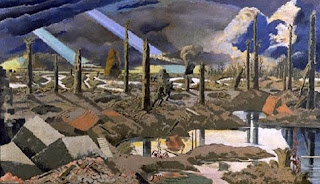Otto Dix (1891-1969) was one of the great artists of the early 20th century, renowned for his harsh modernist, yet realistic depictions of the First World War and postwar German society under the Weimar Republic.
Dix volunteered for military service when war broke out in 1914. An enthusiastic soldier at first, he painted himself as a ferocious "Nietzschean Warrior."
As time went by Dix's enthusiasm for the war dimmed and was replaced by a sense of abject horror, reflected in his "Self-Portrait as Target," with the buttons on his hat reminiscent of the bullseye on a paper target.
Dix's war paintings are among the most ghastly and ghostly done by any artist, reminiscent of Goya's paintings of the Spanish war of liberation against Napoleonic France. One example is the apocalyptic "War." This is part of a larger triptych.
Two versions of "The Wounded Soldier" convey the haunting madness and futility of the war, as does the memento mori "The Skull."
Dix's postwar paintings of Weimar German society often emphasized the horrendous price paid by the nation's military personnel, as in "War Cripples.".
Dix juxtaposed those who had done well out the war and those who endured untold suffering in woks like "Prague Street" with the woman rushing past cripples and its hints of a rising antisemitism.
The triptych "Metropolis" features contrast the suffering of the veterans with the degenerate revelry of the wealthy, uncaring bourgeoisie.
The Nazis hated Dix's paintings as counter-productive to their militaristic and nationalistic goals. They destroyed many of them after exhibiting them in an exhibition called "Degenerate Art."
Friday 27 November 2015
Wednesday 11 November 2015
Art of the First World War
The First World War, which ended a century ago, killed at least 10 million soldiers and millions more civilians, led to the Russian Revolution, the Great Depression, the rise of fascism and Nazism, and World War II. The guns fell silent at the 11th hour of the 11th day, of the 11th month. Clearly, the armistice makers had a sense of history. WWI was not the first war to be photographed or filmed, but none had ever produced so many images in those media. The war also produced a huge body of painting and art, most by those who fought. Here are a few examples, in realistic and more modernist styles.
C.R.W. Nevinson, "Paths of Glory" 1917. "Dulce et Decorum Est, Pro Patria Mori."
Nevinson, "Harvest of Battle" 1919. Blind leading the blind.
Nevinson, "Machine Gun," 1915. French soldiers.
Frank Branwyn, "Tank in Action" (1925) Painted for a public building in Britain. Rejected as "unacceptably morbid." In other words, too accurate.
Henri de Groux, "Gas Masks" (1916). French soldiers. Note resemblance to pigs. Asphyxiation by gas was perhaps the most horrible way of dying.
George Leroux, "L'Enfer" ("Hell") 1917, Suitably named. Artillery killed more men than any other weapon.
William Orpen, "Dead Germans in a Trench" 1918
Paul Nash, "The Menin Road" 1919
Nevinson, "Taube" 1916. Child killed by German aerial bombing. Total War.
Labels:
"Paths of Glory",
Armistice,
art,
artillery,
artists,
First World War,
Frank Branwyn,
gas,
George Leroux,
Henri de Groux,
machine guns..,
paintings. Nevinson,
Paul Nash,
tanks,
William Orpen,
World War I
Subscribe to:
Posts (Atom)

















